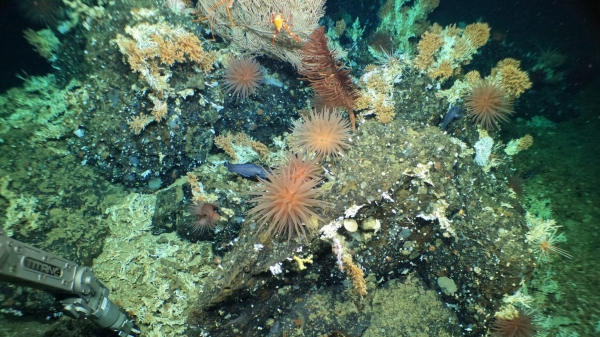Scientists have discovered extensive, ancient deep-sea coral reefs within the Galápagos Marine Reserve (GMR)—the first of their kind ever to be documented inside the marine protected area (MPA) since it was established in 1998. The reef, found at 400-600 meters (1,310-1,970 feet) depth at the summit of a previously unmapped seamount in the central part of the archipelago, supports a breathtaking mix of deep marine life.
Daniel Fornari, marine geologist, and Emeritus Research Scholar at the Woods Hole Oceanographic Institution (WHOI) is a co-lead on the expedition.
Cresting the ridge of an unmapped submerged volcano, and stretching over several kilometers, the impressive reef structure was first recorded by Dr. Michelle Taylor (University of Essex, UK) and Dr. Stuart Banks (Charles Darwin Foundation, Ecuador) while diving in the human-occupied vehicle (HOV) Alvin. This is the first time Alvin has explored this region within the GMR. The submersible recently completed upgrades that included improved high-quality still and ultra-high definition 4K video imaging systems, as well as enhanced sampling capabilities, which allowed for the stunningly clear video of the newly discovered reef sites, as well as the delicate sampling required of the reef. HOV Alvin is owned by the US Navy and operated by WHOI in coordination with the Naval Sea Systems Command (NAVSEA) as part of the NSF-funded National Deep Submergence Facility.
“Exploring, mapping and sampling the Galápagos Platform with Alvin and Atlantis represents an opportunity to apply 21st-century deep-submergence and seafloor mapping technologies and innovative deep-sea imaging techniques to reveal the beauty and complexity of the volcanic and biological processes that makes the Galápagos so unique," said Fornari, who has mapped and sampled the marine environment in the Galápagos for over 20 years.
Read more at Woods Hole Oceanographic Institution
Image: HOV Alvin’s manipulator arm collects samples from rocky outcrop at the crest of a ridge, populated by cold water corals, squat lobsters, anemones, basket stars and deep-sea fish. Credit: Image courtesy of L. Robinson (U. Bristol), D. Fornari (WHOI), M. Taylor (U. Essex), D. Wanless (Boise State U.) NSF/NERC/HOV Alvin/WHOI MISO Facility, 2023 ©Woods Hole Oceanographic Institution


